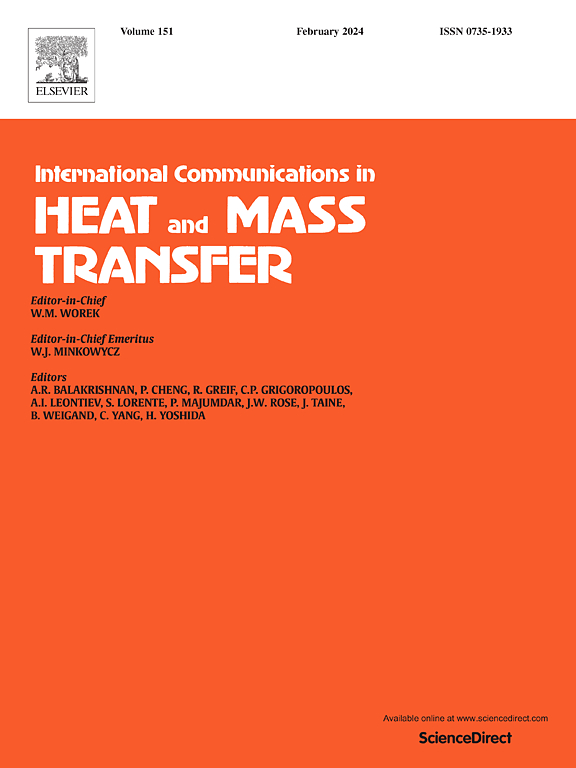电沉积铜毛细管芯的池沸腾增强:交错孔配置与直通孔设计
IF 6.4
2区 工程技术
Q1 MECHANICS
International Communications in Heat and Mass Transfer
Pub Date : 2025-06-13
DOI:10.1016/j.icheatmasstransfer.2025.109188
引用次数: 0
摘要
电沉积制备了微纳杂化多孔材料,显著提高了沸腾传热性能。本研究通过控制电解液中的铜离子浓度产生了两种不同的铜毛细管芯:一种是多层多孔芯(样品#M),具有数百微米的交错孔,另一种是单层芯(样品#S),具有类似大小的直通孔。这两种结构都表现出由亚微米到微米大小的枝晶组成的多孔壁。沸水换热实验表明,样品#S在300 W/cm2时的hMNB为29.4 W/(cm2·K),是样品#M的1.4倍,是光滑铜(样品#O)的5.25倍。样品#S也显示了310 W/cm2的CHF,分别比样品#M和样品#O高121%和270%。毛细管测试和气泡动力学分析表明,样品#S的优异性能源于其非交错的液体输送通道,可以更快地补充液体,并且其通孔设计减少了气泡离开阻力,从而提高了离开频率和半径,从而增强了传热。本文章由计算机程序翻译,如有差异,请以英文原文为准。
Pool boiling enhancement in electrodeposited copper capillary wicks: Staggered pore configuration versus straight through-hole design
Electrodeposition enables the fabrication of micro-nano hybrid porous materials, significantly enhancing boiling heat transfer (BHT) performance. This study produced two distinct copper capillary wicks by controlling copper ion concentration in the electrolyte: a multi-layer porous wick (Sample#M) with staggered pores in the hundreds of micrometers, and a single-layer wick (Sample#S) featuring straight through-holes of similar size. Both structures exhibit porous walls composed of submicron to micron-sized dendrites. Boiling heat transfer experiments reveal that Sample#S achieves an hMNB of 29.4 W/(cm2·K) at 300 W/cm2, 1.4 times that of Sample#M and 5.25 times that of smooth copper (Sample#O). Sample#S also demonstrates a CHF of 310 W/cm2, 121 % and 270 % higher than Sample#M and Sample#O, respectively. Capillary tests and bubble dynamics analysis indicate that Sample#S's superior performance stems from its non-interleaved liquid transport channels, enabling faster liquid replenishment, and its through-hole design, which reduces bubble departure resistance, resulting in higher departure frequency and radius for enhanced heat transfer.
求助全文
通过发布文献求助,成功后即可免费获取论文全文。
去求助
来源期刊
CiteScore
11.00
自引率
10.00%
发文量
648
审稿时长
32 days
期刊介绍:
International Communications in Heat and Mass Transfer serves as a world forum for the rapid dissemination of new ideas, new measurement techniques, preliminary findings of ongoing investigations, discussions, and criticisms in the field of heat and mass transfer. Two types of manuscript will be considered for publication: communications (short reports of new work or discussions of work which has already been published) and summaries (abstracts of reports, theses or manuscripts which are too long for publication in full). Together with its companion publication, International Journal of Heat and Mass Transfer, with which it shares the same Board of Editors, this journal is read by research workers and engineers throughout the world.

 求助内容:
求助内容: 应助结果提醒方式:
应助结果提醒方式:


